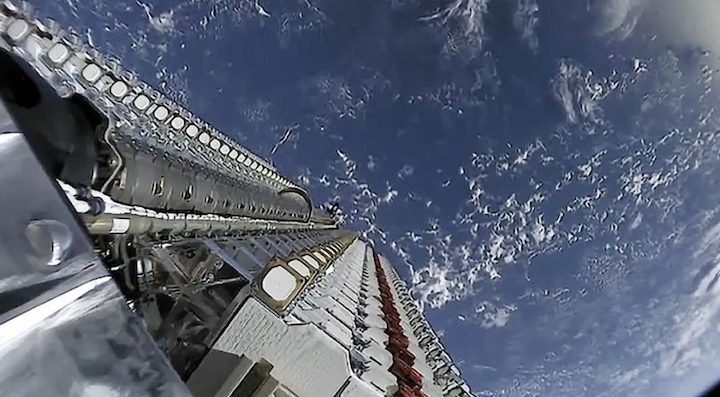11.02.2022

MOUNTAIN VIEW, Calif. — NASA says that SpaceX’s proposal for a second-generation Starlink constellation with 30,000 satellites could lead to a “significant increase” in potential collisions in low Earth orbit and interfere with the agency’s launches and scientific activities.
The five-page letter was submitted to the Federal Communications Commission Feb. 8 on NASA’s behalf by the National Telecommunications and Information Administration, along with a separate one-page letter from the National Science Foundation. The letter was submitted to the FCC’s proceedings on SpaceX’s proposal for its Starlink “Gen 2” system with approximately 30,000 satellites in LEO.
“With the increase in large constellation proposals to the FCC, NASA has concerns with the potential for a significant increase in the frequency of conjunction events and possible impacts to NASA’s science and human spaceflight missions,” stated the letter, signed by Samantha Fonder, NASA’s representative to the Commercial Space Transportation Interagency Group. “NASA wants to ensure that the deployment of the Starlink Gen 2 system is conducted prudently, in a manner that supports spaceflight safety and the long-term sustainability of the space environment.”
The letter raised several issues about the proposed constellation, primarily because it would increase the number of tracked objects in low Earth orbit by more than a factor of five. “An increase of this magnitude into these confined altitude bands inherently brings additional risk of debris-generating collision events based on the number of objects alone,” the agency stated. “NASA anticipates current and planned science missions, as well as human space flight operations will see an increase in conjunctions.”
NASA questioned whether the automated collision avoidance system SpaceX developed for its current Starlink satellites will scale to the larger Gen 2 system. “NASA recommends SpaceX generate analysis demonstrating the auto-maneuver capability is sufficiently scalable to the entire proposed constellation size, including inter-constellation conjunctions, while accounting for challenges in flying lower altitudes during greater solar activity,” the letter stated.
NASA took issue with SpaceX’s claims there is “zero risk” of a Starlink satellite colliding with a large spacecraft because of the Starlink satellites’ maneuverability. “With the potential for multiple constellations with thousands and tens of thousands of spacecraft, it is not recommended to assume propulsion systems, ground detection systems, and software are 100% reliable, or that manual operations (if any) are 100% error-free,” the agency said.
Other constellations that also have autonomous collision avoidance capabilities could cause problems if one of those satellites attempts to avoid a Starlink satellite, triggering a series of maneuvers that could increase, rather than decrease, the risk of a collision unless there are “rules of the road” governing such interactions. NASA recommended SpaceX perform a risk analysis of such events.
Beyond the risk of collisions with NASA and other satellites, the agency said the Starlink Gen 2 system could interfere with science missions. Those satellites will be in orbits below most NASA Earth science satellites and could create reflections of sunlight that interfere with those satellites’ instruments. The Gen 2 constellation could double the number of Hubble Space Telescope images that contain satellite streaks, currently 8% of all images.
The constellation would also risk interfering with ground-based astronomy, in particular observations of near Earth objects as part of NASA’s planetary defense program. With the Gen 2 system, the letter stated, “NASA estimates that there would be a Starlink in every single asteroid survey image taken for planetary defense against hazardous asteroid impacts, decreasing asteroid survey effectiveness by rendering portions of images unusable.”
The Starlink constellation interferes with launches as well. NASA said about 20,000 Starlink satellites would be in orbits below the International Space Station, complicating launches of cargo and crew missions. “NASA is also concerned with an increasing unavailability of safe launch windows, especially for missions requiring instantaneous or short launch windows,” citing the upcoming Europa Clipper mission as one example.
NASA did not state in the letter it was opposed to an FCC license for Starlink Gen 2, instead highlighting areas SpaceX needs to address. “NASA appreciates SpaceX’s collaboration and partnership in addressing conjunction concerns to date,” it stated. “The proposed increase in the number of Starlink spacecraft on orbit will require expanded coordination and communication between the two parties to ensure the continued safety of both SpaceX and NASA assets.”
SpaceX did not immediately respond for a request for comment about the NASA letter and its recommendations. The company infrequently responds to media inquiries.
NASA added that it “has provided similar comments in response to other proposed large constellations.” That includes a letter last year regarding a planned constellation by AST SpaceMobile, where NASA raised concerns about the risk of collisions posed by those satellites with very large antennas. The company has since said it will reduce the size of those antennas.
Mark Dankberg, executive chairman of Viasat, discussed the letter with Jim Bridenstine, former NASA administrator, during a “fireside chat” at the SmallSat Symposium here Feb. 9.
Dankberg, a critic of Starlink but who did not mention SpaceX by name at the event, outlined the various issues NASA raised in the letter, seeing them as costs being imposed on the agency. “There are all of these costs that are being externalized.”
Bridenstine, who serves on the board of directors of Viasat, agreed. “The challenge that I had at NASA is becoming a lot bigger,” he said of past concerns about space sustainability he raised during his time as agency administrator.
He added that the constellation is just one of many proposed by companies and countries. “This is true for every constellation that we’re going to see coming up in the future in how it impacts NASA, which, of course, impacts the American taxpayer,” he said. “This is a real challenge that I don’t think is getting the attention that it needs as we move forward.”
Quelle: SN
